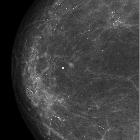chronische abakterielle Mastitis









Plasma cell mastitis is a benign breast condition which represents calcification of inspissated secretions in or immediately adjacent to ectatic benign ducts.
Epidemiology
It is typically seen in older women (e.g. >60 years of age).
Pathology
It is thought to represent aseptic inflammation of the breast from extravasation of intraductal secretions into periductal connective tissue.
Radiographic features
Mammography
Plasma cell mastitis has a characteristic appearance. Calcifications are thick, linear, rod-like or cigar-shaped. Calcifications can be up to 10 mm long. They tend to be bilateral, often symmetrical in distribution and oriented with long axes pointing toward the nipple. Branching may sometimes be seen.
Compared to microcalcifications of DCIS or ductal carcinoma, calcifications of plasma cell mastitis are larger in both length and caliber and have a smoother outline.
Treatment and prognosis
It is a benign entity and there is no increased risk of malignancy .
Siehe auch:
- Verkalkungen in der Mammographie
- Granulomatose mit Polyangiitis
- Mikrokalk in der Mammographie
- Mastitis
- duktales in situ Karzinom der Mamma
- Duktektasie der Mamma
- Milchgangverkalkung
- idiopathische granulomatöse Mastitis
- lanzettförmige Verkalkungen
- Tuberkulose der Mamma
- subareolärer Abszess
- Neoplasien der Mamma
- Sarkoidose der Mamma
und weiter:

 Assoziationen und Differentialdiagnosen zu chronische abakterielle Mastitis:
Assoziationen und Differentialdiagnosen zu chronische abakterielle Mastitis:








